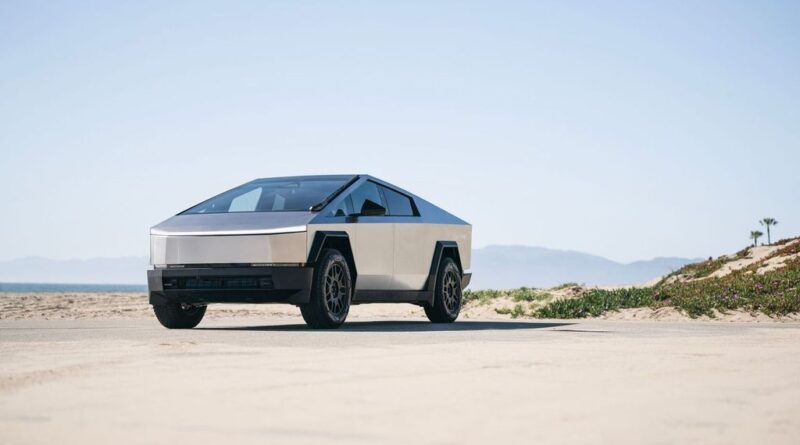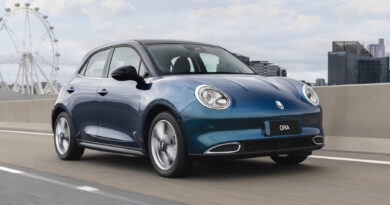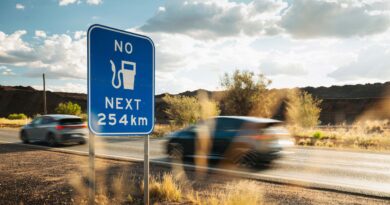2025 Tesla Cybertruck driven: Here’s what you need to know about the giant electric ute for Australia
Despite all the obvious risks to our safety and our pride, EV Central recently flew to Los Angeles to drive the new Tesla Cybertruck.
I’m still trying to compose myself enough to compose a review, which will be here soon, but you can watch the preview video below.
While hanging out with the cool and not at all weird or cult-like people from Tesla I also discovered some important things about the Cybertruck and just how keen the company is to put it on sale here.
It describes Australia as “the perfect environment” for the giant vehicle, despite the fact that it is too big to fit in any of our car spaces. They also referred to us as “a big truck market”, which made me sad and slightly ashamed.
READ MORE:
When will Australians with Tesla Cybertruck orders receive their EVs?
Rivian R1X performance pick-up set to rival Tesla’s Cybdertruck

In other wonderful news, it turns out that, despite all reports to the contrary, including from people who own them, Cybertruck, officially, does not rust.
When we turned up to drive the thing, we were given a short, four-hour rundown by a Tesla technician/acolyte/sales person on how to drive it, and where all the silly Easter eggs are hidden (my favourite is that if you smash the windows on the touchscreen graphic of the Cybertruck with your finger you get to hear the sound of Elon swearing and chuntering during the infamous failure demonstration of its bowling-ball-proof glass).
At one point, I asked him about the rust issue.
“There is no rust,” he said.
“Really, but owners say they’re seeing it?”
“There is no rust,” he repeated, looking me fiercely in the eyes, like a preacher, insisting that I believe.
“So what happens is the rust spots everyone sees, you’ll notice they’re only on the top-facing panels, you’ll never see it on the sides, you only see this on the hood, and sometimes the back,” he continued.
“The reason being is all the Cybertrucks come on a train up from Texas, from Austin, and the iron in the train box basically doesn’t mix with the steel. So it’s something called oxidation, see.”
Look, I’m all in favour of blaming Texas for things, but at this point I may have been looking at him like he was telling me he’d ridden to work on a unicorn that morning.
“It’s like iron oxidation. Basically it hits the steel and it’ll stay on there, it’s basically particles falling off, but it’s super easy to take off, and we do that process here when they arrive.
“So, just like when it travels and sometimes you might get those little dots or oxidation like that. Other than that, the rain doesn’t do anything to it.”

He also insisted that it was fine with mud – good to know about your off-road ready pick-up monster truck – and sea air was also fine.
“But they don’t rust,” he intoned, fiercely, again.
“You can keep it in the rain for as long as you want.”
What he did admit, however, was that the one thing everyone asked him about was the fingerprints, which the Cybertruck is constantly covered in, because stainless steel surfaces do that. He didn’t deny that this was a problem, but he pointed out that it’s just a matter of cleaning it every single day, sometimes many times a day.
“They always ask about how to get fingerprints off. The main thing, what I tell everyone, is it’s like cleaning a fridge, so it’s the same exact material as a steel fridge you have in your kitchen. Isopropyl alcohol is the best, but anything that cleans fingerprints off your fridge will work,” he explained.
So, how much would this fridge on wheels cost if it actually did come to Australia? It’s difficult to say, but if it was close to $200,000 it wouldn’t be a huge surprise. In the US, if you wait in line – and word has it there are already 2 million pre-orders – the price is between US$81,895 and US$101,985 for a Cybertruck.
Despite the fact that, at a production volume of 200,000 to 250,000 a year, it’s going to take many years just to fulfil North American demand, Tesla executives say they are still “extremely hopeful” of getting Cybertruck to a right-hand drive market like ours.

Perhaps the most senior man with that plan happens to be an Australian, Daniel Ho, who grew up in Melbourne, has previously worked at Ford, and is now Tesla’s Director, Vehicle Programs and New Product Introduction. He’s worked closely with Elon Musk for more than 10 years, and still wants to do so. Go figure.
“There are challenges, but we are still extremely keen to make it happen,” he said of Cybertruck.
A standard Australian parking space is 2.4m to 2.6m wide, and just 5.4m long, while the Cybertruck is 5.68m long, 2.03m wide, and 1.8m high. Fortunately, Daniel explained that it’s just not as big as you think it is.
“When people actually see it, it’s not as big as they think it’s going to be; obviously it’s bigger than a HiLux, bigger than a Ranger, bigger than a Navara, but it’s smaller than a Ram, and Australia does have those,” he said.
“When it comes to pedestrian safety, the laws here are very different to the ECE (Economic Commission for Europe), and therefore the Australian regulations, and it’s not just about size and height, it’s also radius as well, there are minimum radii (rounded edges) that the Cybertruck doesn’t have, because when you look at it there are so many sharp angles and edges.
“So there are some challenges there, but we’d love to bring it to Australia, I would love to see it there personally, because it would be a great environment for it, and obviously it’s a big truck market as well. And it would be so good for the off-road adventure kind of market.
“But we remain extremely hopeful that we can make it happen.”




